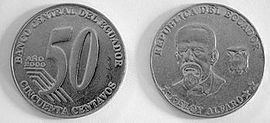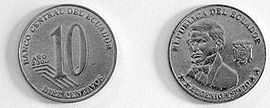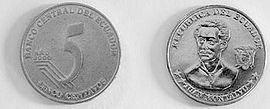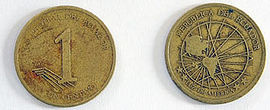
Ecuadorian centavo coins
Encyclopedia





Ecuador
Ecuador , officially the Republic of Ecuador is a representative democratic republic in South America, bordered by Colombia on the north, Peru on the east and south, and by the Pacific Ocean to the west. It is one of only two countries in South America, along with Chile, that do not have a border...
converted its currency from the sucre
Ecuadorian sucre
The sucre was the currency of Ecuador between 1884 and 2000. Its ISO code was ECS and it was subdivided into 10 decimos or 100 centavos. The sucre was named after Antonio José de Sucre.-History:...
to the U.S. dollar
United States dollar
The United States dollar , also referred to as the American dollar, is the official currency of the United States of America. It is divided into 100 smaller units called cents or pennies....
. The coins are in denominations of 1, 5, 10, 25 and 50 centavos and are identical in size and value to their U.S. cent counterparts (although the U.S. 50-cent piece is rarely used.) They circulate within Ecuador alongside coins and banknotes from the USA
United States
The United States of America is a federal constitutional republic comprising fifty states and a federal district...
. Unlike in the United States, the United States $1 coin is commonly found in circulation. Ecuador does not issue any banknotes, relying on U.S. issues.
Ecuadorian centavos all bear the numeric value along with the value spelled out in Spanish
Spanish language
Spanish , also known as Castilian , is a Romance language in the Ibero-Romance group that evolved from several languages and dialects in central-northern Iberia around the 9th century and gradually spread with the expansion of the Kingdom of Castile into central and southern Iberia during the...
, and the legend of the Banco Central del Ecuador; the reverse is printed with the portrait and name of a notable Ecuadorian, the legend "República del Ecuador" and the country's Coat of Arms
Coat of arms
A coat of arms is a unique heraldic design on a shield or escutcheon or on a surcoat or tabard used to cover and protect armour and to identify the wearer. Thus the term is often stated as "coat-armour", because it was anciently displayed on the front of a coat of cloth...
. The exception is the one-cent coin, which rather than bearing a portrait, is printed with a map of the Americas and bears the legend "Ecuador, Luz de América" ("Ecuador, Light of America"). Coins bear the date Año 20xx, beginning in 2000; the largest proportion of coins in circulation are from the 2000 minting. With the exception of the one-cent coin, the coins are silver
Silver
Silver is a metallic chemical element with the chemical symbol Ag and atomic number 47. A soft, white, lustrous transition metal, it has the highest electrical conductivity of any element and the highest thermal conductivity of any metal...
-colored; the "un centavo" coin is generally brass
Brass
Brass is an alloy of copper and zinc; the proportions of zinc and copper can be varied to create a range of brasses with varying properties.In comparison, bronze is principally an alloy of copper and tin...
in color although a few were struck in copper color (unlike most other pennies, whose similar coins are of copper
Copper
Copper is a chemical element with the symbol Cu and atomic number 29. It is a ductile metal with very high thermal and electrical conductivity. Pure copper is soft and malleable; an exposed surface has a reddish-orange tarnish...
). The coins are minted by the Royal Canadian Mint
Royal Canadian Mint
The Royal Canadian Mint produces all of Canada's circulation coins, and manufactures circulation coins on behalf of other nations. The Mint also designs and manufactures: precious and base metal collector coins; gold, silver, palladium, and platinum bullion coins; medals, as well as medallions and...
and the Casa de Moneda de Mexico
Mexican Mint
The Casa de Moneda de México is the national mint of Mexico and the oldest mint in the Americas, established in 1535.Since 1983, coins are only produced in San Luis Potosí in Mexico and the main client is the Banco de México...
.

